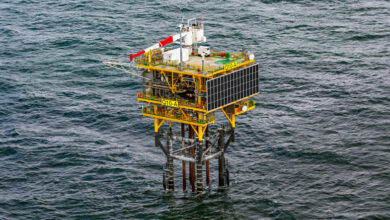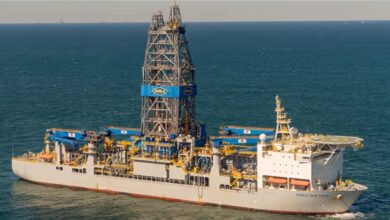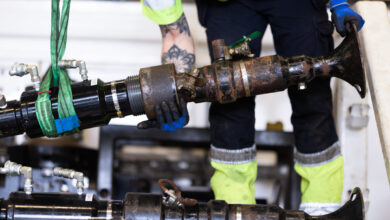Annual rig census finds drilling activity in upward trend
By Linda Hsieh, managing editor

Land rig utilization is looking up, or at least steady, in the US and most markets around the world as contractors continued to replace older-style mechanical rigs with newer electric units, according to the 2011 National Oilwell Varco annual rig census. The results show, however, that global offshore activity slumped slightly even though the number of available offshore rigs has risen.
Jeremy Thigpen, president of NOV downhole tools and pumping solutions, presented the census findings at the 2011 IADC Annual General Meeting on 11 November in Austin, Texas.
Looking at only the US market, the number of available rigs as counted during the census period from 4 May to 17 June this year went down to 3,081 from 3,153 last year. Although this number doesn’t reach the 1982 peak of 5,644 rigs, it is higher than the average number of rigs available during the census history since 1955 – 2,670.
In contrast to rig availability, the active rig count increased slightly from 2,024 in 2010 to 2,059 in 2011. “Looking at this, I think the most important thing to acknowledge is two years ago we were down to 1,264 (active) rigs. This has been quite a nice uptick over the last two years … and we’re certainly hoping that continues,” Mr Thigpen said.
A total of 262 rigs were added to the US rig fleet in 2011, which is more than the 243 units added in 2010. As has been the trend over the past few years, the bulk of these 262 rigs were newly manufactured (158); of these, 154 were land rigs, one was a floater, one was bottom-supported, one was a platform and one was a barge.
Mr Thigpen pointed out that the newbuilding program that’s been under way for several years means that 42% of the US fleet is only six years old or younger.
In addition to the newbuilds, 95 units were brought back into service, six were moved into the country and three were assembled from parts.
As active as rig construction has been, contractors appear to have been even more active in taking rigs out of the fleet – at twice the rate they’re adding new rigs. In 2011, 315 rigs were intentionally removed from service, compared with 212 taken out in 2010. “What you’ll see is that most of the rigs being removed are the older, low-horsepower, mechanical rigs,” Mr Thigpen said.
Coupling these removals with the 16 rigs moved out of the country and the three rigs that were destroyed in accidents, a total of 334 rigs were taken out of the US rig fleet this year, compared with 259 last year.
Looking at rig utilization, the census found that 67% of available rigs were working during the census period, showing a 3% increase over last year’s utilization number. Although 67% is below the historic mean since 1955 of 74%, it should be noted that utilization stood at just 40% in 2009. That was the lowest point the US industry had seen in about 20 years. “We’re certainly moving in the right direction. We’re not to the mean yet, but hopefully we’ll get there in the next couple of years,” Mr Thigpen said.
In Canada, the number of available rigs went down by 21 units to 774 in 2011. Rig activity, however, is up about 10%, with 369 active units. This combination made for an increase in utilization, from 42% last year to 48% this year.
The global offshore rig fleet, excluding platforms and inland barges, now stands at 794, having gained 49 rigs over last year. Offshore activity has declined by 2% for an active rig count of 559. This dragged down utilization from 77% in 2010 to 70% this year.
In drilling markets outside the US, rig utilization for all markets except one remained stable or went up. “If you think about the Arab Spring and the effect that had on Egypt, Libya, Syria, Yemen, you would’ve thought that Middle East and Africa would be negatively impacted,” Mr Thigpen remarked. However, utilization went from 77% to 83% in Africa and from 90% to 97% in the Middle East. Higher activity in Saudi Arabia and Iraq are thought to be the cause of these activity increases.
In Latin America, PEMEX activity as well as Brazil boosted utilization from 74% last year to 93% this year.
Asia Pacific rig utilization remained steady at 96%, and the only market that showed a decline was Europe, including the Former Soviet Union, where utilization dropped from 86% to 80%.
In addition to the rig census, NOV also surveyed US contractors and found that their top three concerns remained the same as in 2010: rig rates, crew availability and government regulations. Despite these concerns, most contractors were optimistic about the near- and long-term outlook. “In fact, we had 46% who are expecting to expand their current fleets, so that’s encouraging,” Mr Thigpen said.
He continued: “As we look to next year, assuming we don’t have an economic meltdown, we see much of the same. We think the industry is going to continue to focus on removing those rigs that are the older, mechanical, less efficient rigs and replacing them with some of the higher-horsepower electric rigs. We think the available rig count will remain relatively flat. … We also hope activity will continue to increase.”




